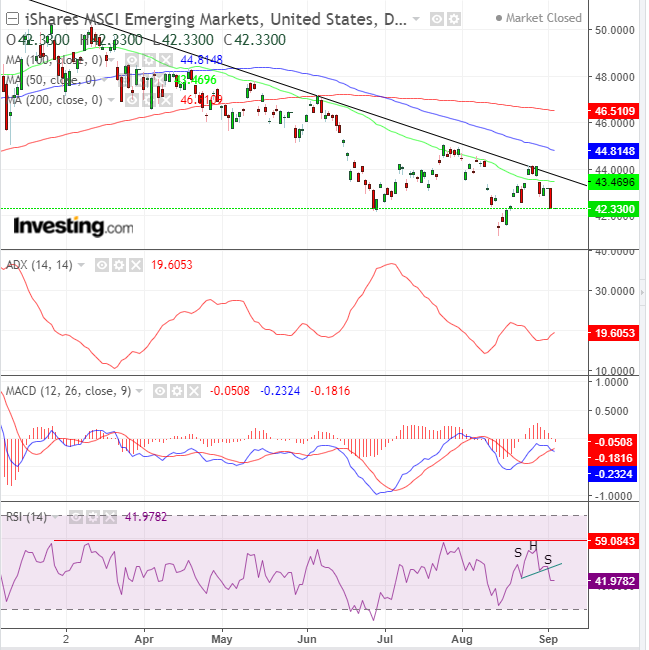In recent days, emerging markets have grabbed the spotlight, moving markets and pushing even the ongoing US-China trade war into the background. EM assets have been pummeled, hit multiple blows—everything from weakening currencies to shrinking economic activity, to geopolitical events.
Add to the list improving economic data out of the US that continues to support the Fed's tighter path for interest rates which has been increasing the demand for the dollar. At the same time other major markets have been struggling simply to begin to make the transition to normalization after the most accommodative monetary policy in history.
This ever widening, dollar-positive, interest rate differential has sucked investments out of the emerging markets. The inter-market dynamic, between a strengthening dollar and rising EM risk, appears to have become self-propelled ratcheting the ever dollar higher and pressuring emerging markets increasingly lower.
The iShares MSCI Emerging Markets ETF (NYSE:EEM) has been falling since late January. It lost a total of 21 percent by August 15, though it's now recovered a bit, down almost 19 percent as of yesterday's Wall Street close, where it finished at the bottom of the session.
The 50 DMA (green) has been aligned with the downtrend line since January, demonstrating its relevance as the rate in which supply has been overcoming demand. After just three days above the 50 DMA in August, the price fell back below that line, having failed to cross over the downtrend line.
The MACD provided a sell signal when the shorter MA fell below the longer MA, demonstrating recent price weakness. As well, the RSI has completed a H&S top, after reaching the 59 level, its highest point since the January selloff.
Note that the Average Directional Index (ADX) is on the rise—attesting to the strength of the downtrend—while the ADX was falling on the rallies, revealing weakness. Currently at 19.6, it's on the verge of breaking the 20 level, where it would send a "strong trend" signal.
If it's difficult to believe that emerging markets still have still room to fall, consider the following two points:
- After plunging by 21 percent, it entered a bear market, in which investors presume that rallies are nothing more than a correction and declines are seen as part of the prevailing trend.
- The larger weekly perspective is even more bearish
To reach the 2016 bottom, prices still have a long way to go, a drop of almost another 35 percent.The chart above also illustrates the negative correlation between emerging markets and the US Dollar Index (purple line).
Trading Strategies - Short Position Set-Up
Conservative traders should wait for a new trough to extend the current downtrend, after registering a price below the August 15, 41.13 low.
Moderate traders may short a potential pullback toward the downtrend line at about 43.6000.
Aggressive traders may short now, providing they have an equity management plan that provides a 1:3 risk-reward ratio.
Trade Sample: Conservative Trader
- Entry: 41.00
- Stop-loss: 42.00
- Risk: $1
- Target: 35.00, above December 2016 lows
- Reward: $6
- Risk-Reward Ratio: 1:6
Trade Sample: Moderate Trader
- Entry: 43.00
- Stop-loss: 43.50
- Risk: $0.5
- Target: 41
- Reward: $2
- Risk-Reward Ratio: 1:4
Trade Sample: Aggressive Trader
- Entry: 42.30
- Stop-loss: 43.30
- Risk: $1.00
- Target: 39.30
- Reward: $3
- Risk-Reward Ratio: 1:3


